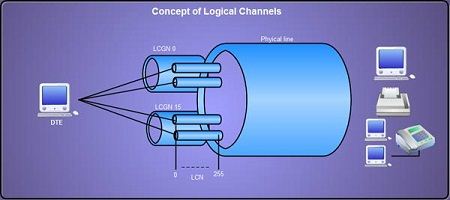The terminal connected to the packet switched network can communicate with multiple terminals at the same time using a single physical line. This makes it possible to set multiple logical paths called logical channels on a single physical line.
Multiple communication thus takes place through these logical channels. Based on the X.25 roles, 4096 logical channels can be set on a single physical line connected to a DTE. These 4096 logical channels can be grouped into 16 groups and each group containing up to 256 channels. These channel groups are known as LCGN (Logical Channel Group Number) and LCN (Logical Channel Number) as shown in Figure. When data is transferred over virtual circuits, specific channel numbers and channel group numbers are allocated for use by all packets included in that transfer.

 Dinesh Thakur holds an B.C.A, MCDBA, MCSD certifications. Dinesh authors the hugely popular
Dinesh Thakur holds an B.C.A, MCDBA, MCSD certifications. Dinesh authors the hugely popular